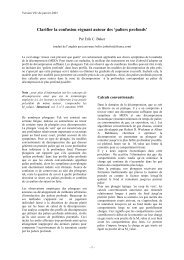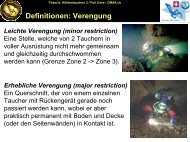cave diving and the nss - bei Swiss-Cave-Diving
cave diving and the nss - bei Swiss-Cave-Diving
cave diving and the nss - bei Swiss-Cave-Diving
Create successful ePaper yourself
Turn your PDF publications into a flip-book with our unique Google optimized e-Paper software.
LIGHT SIGNALS 7<br />
Chapter Three<br />
LIGHT SIGNALS<br />
A photographer we know has a sign outside his darkroom that<br />
reads, "Caution: Keep door shut or all of <strong>the</strong> dark will leak out."<br />
He claims that occasionally somebody'll fall for it. Well, be that as<br />
it may, it is true that occasionally people who know nothing about<br />
<strong>cave</strong>s will ask, seemingly seriously, "You mean it's possible to <strong>cave</strong><br />
dive at night? But doesn't it get awfully dark inside <strong>the</strong> <strong>cave</strong>?" (Uh,<br />
right. . . What college did you say you graduated from?)<br />
But it's probably not fair to be too hard on <strong>the</strong>m. After all, a<br />
lot of fairly intelligent people seem to have difficulty with <strong>the</strong> concept<br />
that what qualifies as a "<strong>cave</strong>rn" dive* during <strong>the</strong> daytime, becomes<br />
a full-blown "<strong>cave</strong>" dive** at night. A lot of people also seem to<br />
have difficulty grasping <strong>the</strong> idea that small lights, which are adequate<br />
for night <strong>diving</strong> <strong>and</strong> <strong>cave</strong>rn <strong>diving</strong>, are only good enough to<br />
be used as emergency backup lights for <strong>cave</strong> <strong>diving</strong>.<br />
<strong>Cave</strong>-<strong>diving</strong> generally requires at least one very bright light,<br />
which we refer to as <strong>the</strong> "primary light." With a good primary, a<br />
<strong>cave</strong> with white or light-colored rock will be astonishingly well illuminated.<br />
A bright, powerful light also makes it easier to keep<br />
track of <strong>the</strong> line without having to be right on top of it at all times,<br />
to reference <strong>the</strong> <strong>cave</strong> passageways in both directions, to plan your<br />
swimming <strong>and</strong> buoyancy strategies well in advance, to keep tabs<br />
on your buddies, to have your buddies keep tabs on you, <strong>and</strong> to<br />
attract your buddies' attention should you need to.<br />
But because primary lights are so bright, it is especially important<br />
to avoid temporarily blinding <strong>and</strong> destroying your buddies'<br />
night vision. Care must always be taken not to shine your light<br />
* which we define as a dive within <strong>the</strong> natural daylight zone of <strong>the</strong> <strong>cave</strong><br />
** a dive which is beyond <strong>the</strong> reach of daylight<br />
directly at your buddy's face. If<br />
you see your buddy looking in<br />
your direction, you can point your<br />
light down or off to <strong>the</strong> side to<br />
spare him <strong>the</strong> full force of <strong>the</strong><br />
glare. This can be hard to<br />
remember to do sometimes when<br />
you are focused in on some o<strong>the</strong>r<br />
engaging task. But with frequent<br />
mental review it can become<br />
practically an instinctive habit.*<br />
Care should also be taken<br />
not to make too many unnecessary,<br />
r<strong>and</strong>om, jerky movements<br />
with your light. These can be mistaken for light signals. If your<br />
light is constantly flashing around carelessly, your buddy will learn<br />
to ignore it, <strong>and</strong> when you really do need to get his attention, you<br />
may find yourself in <strong>the</strong> unfortunate position of <strong>the</strong> boy who cried,<br />
"Wolf!" Good <strong>cave</strong> divers try to keep <strong>the</strong>ir normal light movements<br />
smooth, slow, <strong>and</strong> controlled.<br />
With this in mind, suppose you notice that your buddy behind<br />
you seems to be making light movements which, while <strong>the</strong>y are<br />
clearly not a direct signal, are definitely more erratic than normal.<br />
As an alert partner, you will want to observe him more closely to<br />
determine if he is just making some minor adjustment or if this<br />
might be <strong>the</strong> prelude to a more difficult situation. Typically, <strong>the</strong> diver<br />
isn't concerned enough to formally signal you <strong>and</strong> halt <strong>the</strong> dive.<br />
But if you're alert, you can slow down <strong>and</strong> let him see that you're<br />
watching him <strong>and</strong> willing to pause for a moment if he so desires.<br />
An important part of communicating underwater in a <strong>cave</strong> is<br />
<strong>bei</strong>ng receptive to <strong>the</strong> communication in <strong>the</strong> first place. You can't<br />
just swim along in a coma <strong>and</strong> forget that your buddies exist. Being<br />
a good buddy is a lot like <strong>bei</strong>ng a good friend: you have to meet<br />
your friends half way; you have to listen, not just hear. You have<br />
to care about <strong>the</strong> o<strong>the</strong>r divers—<strong>the</strong> o<strong>the</strong>r people—you're with,<br />
* Divers who wear <strong>the</strong>ir lights attached to <strong>the</strong>ir helmets may have a more difficult<br />
time of this, because of <strong>the</strong> horse-blinder effect of masks, which makes it hard<br />
to see things without turning your head, <strong>and</strong> thus your helmet <strong>and</strong> light, directly<br />
towards <strong>the</strong>m.















